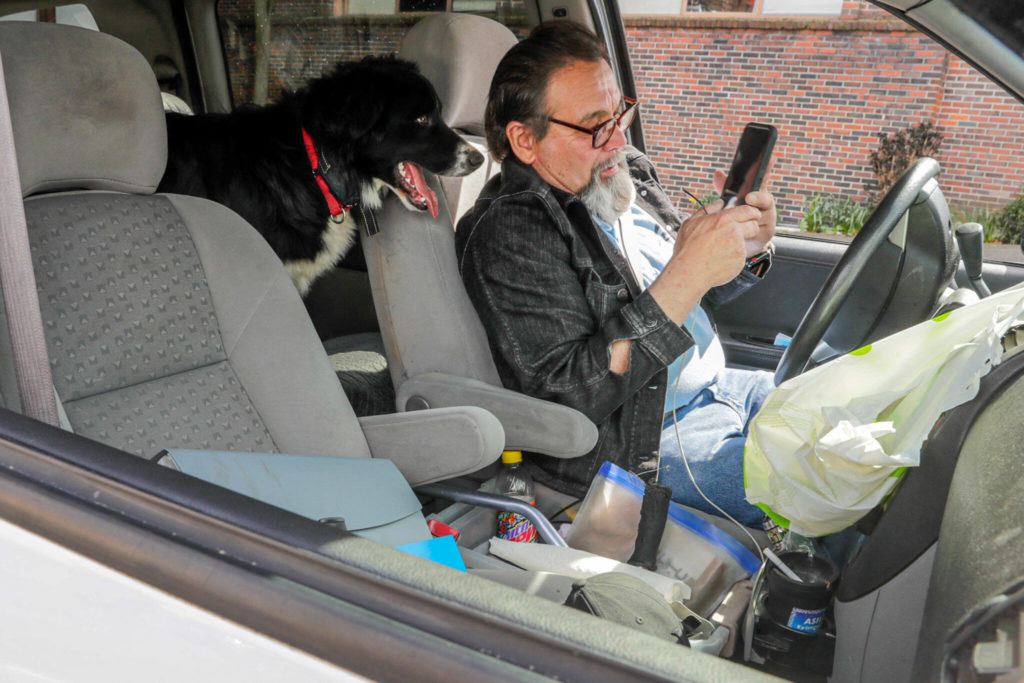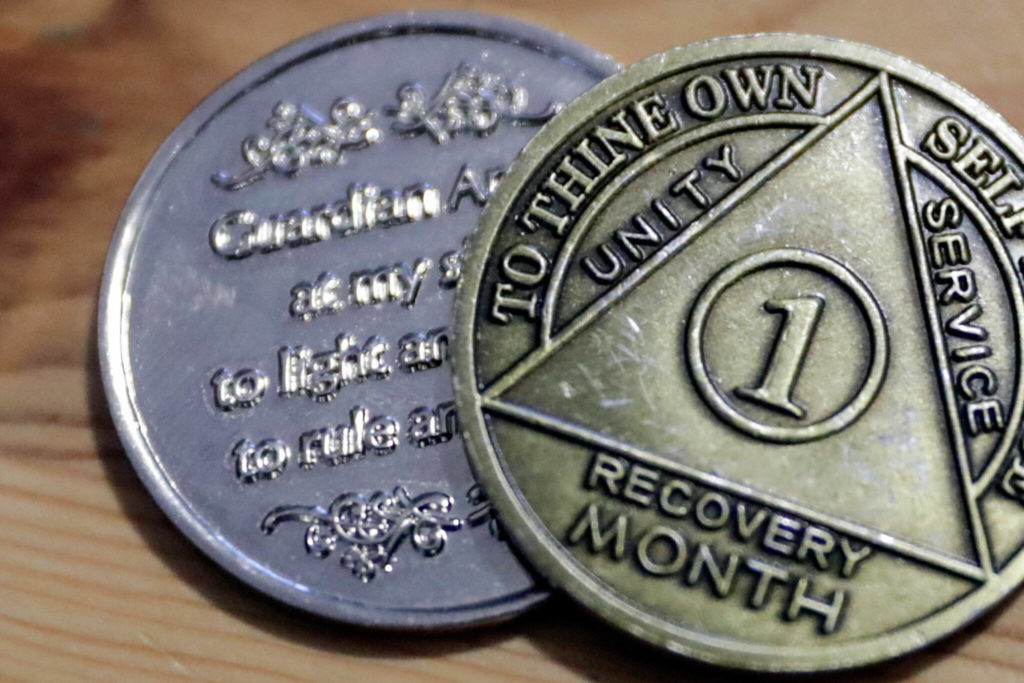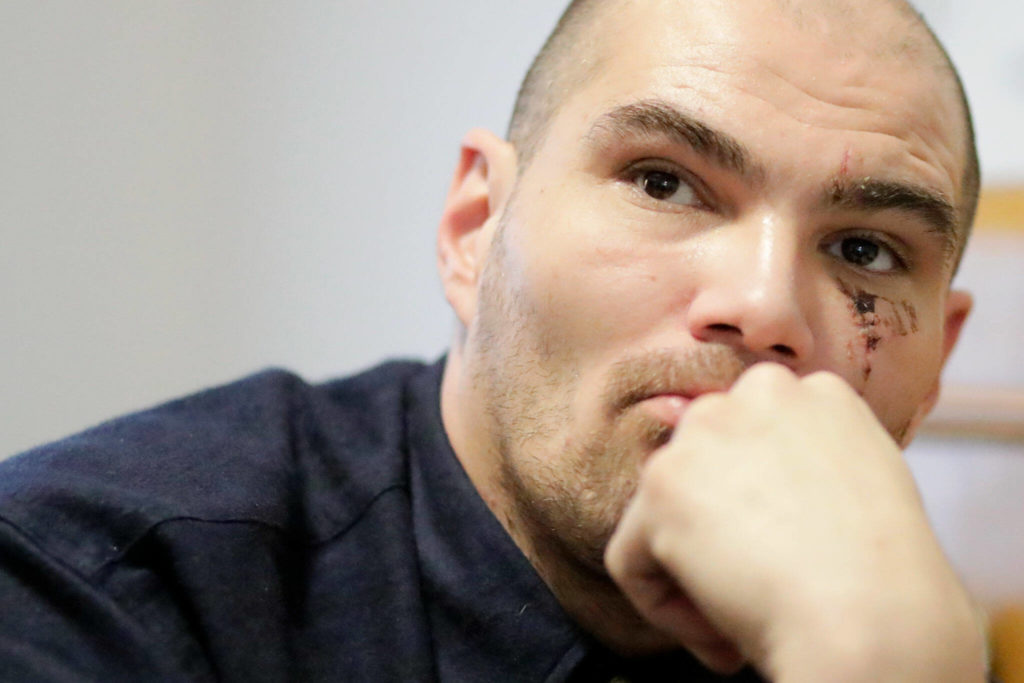EVERETT — Randy Tharp remembers five Magic Bullet blenders on his kitchen counter. Just a few months ago, he used them to blend up fentanyl, cut it with “whatever” and cram the powder into a pill press.
Tharp pumped about 2,000 of those blue fentanyl pills into the region each day from a south Everett apartment complex he calls “the Jack-in-the-Box of the drug trade.”
“The market changed so quickly, it was ridiculous,” Tharp, 34, told The Daily Herald. “Heroin is pretty much an obsolete drug. It’s the fentanyl epidemic now.”
The synthetic opioid can be made illegally. It’s 50 to 100 times stronger than morphine. In Everett, Tharp said, it was dealers like him who “flooded the market” during the pandemic, sending a wave of fentanyl crashing over the community. Supply soared. Prices plummeted for blue pills stamped “M30.” Tharp smoked them constantly.
“Guess what? The homies aren’t pharmacists. The homies don’t got no Ph.D. Yet we’re pressing pills like we do,” Tharp said. “I can’t tell you how you should press a pill. So you’re getting one pill that’s crap and you’re getting one pill that’s going to kill you.”
From 2018 to 2021, Snohomish County’s annual fentanyl deaths more than tripled, from 47 to 156. The county has the second-highest synthetic opioid death rate in the state and the highest in Western Washington — more than double the rate in neighboring counties, per the most recent data from the University of Washington.
As the powerful drug tightens its grip on the community, the opioid crisis is taking on a new form, according to both doctors and those struggling with addiction. Not all treatment providers are set up for it.
Fentanyl’s potency means overdoses are becoming harder to reverse. Providers are trying to keep up with new synthetics and deadly combinations. For those trying to get sober, detox has become a longer, more painful process.
“I’ve detoxed off heroin, (oxycodone), everything,” Tharp said. “And I will honestly say this is the worst detox I’ve had. I’ll take 10 withdrawals off heroin over one withdrawal off of fentanyl. It’s so extreme. … That’s why everybody’s so scared to get clean.”
Fentanyl hasn’t garnered enough attention in the shadow of COVID-19, said Dr. Todd Carran, an addiction specialist at Providence. The Everett hospital runs a 14-bed detox. He only started hearing about fentanyl addiction in his patients about three years ago. They were maybe smoking a few pills a day, Carran recalled. Now, some are up to 50.
“I have so many parents in here who have no idea what I’m talking about when I talk about fentanyl,” Carran said. “People in the community don’t know about fentanyl. And it shocks me.”
On a recent overcast afternoon, Tharp took a drag from his cigarette on his front porch in Lynnwood. These days, he shares a clean-and-sober house with more than two dozen adults in recovery.
After two decades using and dealing drugs, Tharp has lived through waves of epidemics. The meth epidemic gave way to the oxy epidemic that gave way to the heroin epidemic, he said. Now heroin is harder to find. And fentanyl is cheap.
“The main problem here is you can’t treat this like heroin. It’s not heroin. Fentanyl’s a whole new demon,” Tharp said. “Believe me. I’ve held more friends dying of ODs from fentanyl than all the other epidemics combined.”
“This has swept us,” he said. “You hold your dying friend, waiting for your ambulance to get there. He’ll die. And two minutes later you’ll be in the hallway smoking another blue pill. One of the main reasons why I wanted to do this interview is because I’ve done nothing but deal death to this community.”
Tharp didn’t ask for anonymity for this story.
He wanted to go on the record because “I don’t think society realizes how big a problem it is. Because this epidemic is huge. Bigger than anything I’ve ever seen before. Like, scary huge — even for me.”
‘Please don’t send me home yet’
Sean Brown thought something was wrong with him when he detoxed off fentanyl a few months ago. In a Skagit County treatment center, he was told the process would take five days — about how long his heroin detox took.
But after discharge, Brown was in withdrawals for another 10 days.
“I was just not sleeping, I had chills. I mean, it was so bad,” Brown said. “It’s easy to call the dope man.”
Brown isn’t alone.
Fentanyl lingers in fat cells longer than many drugs. It’s unclear how long it takes to leave the body.
Carran reckons it’s about 19 to 27 days. Robert Smiley, who helps people recovering from addiction through The Hand Up Project, believes 21 to 28 days. Mishele Rutherford, a director at Evergreen Recovery Centers, says 10.
In a recent Boston University study, participants took one to two weeks to receive a negative urine test. One patient continued to test positive for a fentanyl metabolite for 26 days, and left treatment without testing negative.
“Four days is when you’re just starting to clear out your major tissue reserves,” Carran said. “And then the withdrawal can get worse at that point.”
Providers told The Herald that longer in-patient detox programs could save lives. Yet they are largely bound by what insurance companies will cover. For now, that’s about five days.
At Evergreen, nurses can ask insurers to pay for longer, but they have to prove there’s a medical need.
“And honestly, the bandwidth to prove to insurance companies (that we need more days), we don’t have that,” Rutherford said. “We’re Medicaid-funded. We don’t have extra resources or extra staff to do that. … I don’t have the time to go educate them.”
Meanwhile, some locals say short detox programs just don’t work.
One 42-year-old Everett mom, who asked to remain anonymous for the sake of her children, said she begged Providence doctors, including Carran, to extend her detox.
“I said, ‘Please don’t send me home yet. I’m going to walk out those doors and I’m going to relapse.’ I started bawling,” the woman said. “I thought I had good insurance before, but they didn’t cover it. At least that’s what the hospital told me.”
Carran was compassionate, she said, but “it felt like his hands were tied.”
She relapsed. Another five-day detox program in Oak Harbor didn’t stick, either. Finally, a new insurance provider helped pay for a 15-day detox in California.
“I know it sounds like a long time for detox, but it was very necessary,” she said. “They had to hold me down to try to get my vitals, because I physically could not stop jumping around and kicking and punching.”
The Everett woman described the process as “absolute hell — I’ve never felt that pain and that terror.”
She’s now more than three months sober.
‘The brain just can’t tolerate it’
Samuel Hirst uses a PowerPoint presentation to train nurses and employees at Evergreen’s 16-bed detox center in Lynnwood.
In bold green letters, one slide asks: “WHY ARE WE SEEING SO MUCH PRECIP W/D?”
Precipitated withdrawal — the rapid onset of intense withdrawal symptoms — can happen accidentally if a patient is given treatment medications too early, before opioids have enough time to drain from the body.
With heroin, Rutherford said, patients can be given Suboxone within 12 to 18 hours. The medication eases withdrawal symptoms, blunts cravings and prevents overdoses. With fentanyl, they’re having to wait several days.
Precipitated withdrawal won’t kill patients, Rutherford said. “But it is to the point where they want to die.”
She said there are local “horror stories” of providers treating fentanyl like heroin, unaware that doing so can have dire consequences.
Even normal, non-precipitated withdrawals had Tharp “crawling out of my skin.” He described “living in the shower” for the first three days of his detox, before he could start Suboxone. He suffered from severe diarrhea and vomiting.
At Providence, Carran cares for patients who refuse Suboxone due to negative experiences with it. But without the medication, withdrawal symptoms can drive a person to relapse.
“They’re usually so miserable that they don’t stick around,” Carran said. “They leave against medical advice, and that really scares me … to think you’re going to stay abstinent is not realistic, and it’s extremely dangerous.”
With intense cravings and no medication in their system, Carran said, those patients are more at-risk of overdosing than they were when they first came in.
“I just fear a lot of those people are going to overdose and die,” he said.
Carran recalls a time when insurance companies wouldn’t pay for in-patient opiate detox at Providence at all. That’s because detoxing from other opioids was thought to be uncomfortable, but not life-threatening.
Now, he said, he’s grappling with a “brand new diagnosis” — fentanyl withdrawal delirium. Carran compared the dangerous condition to alcohol withdrawal delirium, which can manifest in tremors, confusion and hallucinations. He’s placing some patients in posey beds: zipped-up mesh enclosures that prevent patients from hurting anyone.
“The brain just can’t tolerate it,” Carran said.
‘Sick concoctions’
Mike Kersey can drive over 1,000 miles a week in his white passenger van. He spends his days fielding dozens of phone calls from locals trying to get off fentanyl. He’ll pick them up that day and get them to detox.
Oftentimes, that means driving all the way to Bellingham or Oak Harbor.
“I’ll tell you right now, there aren’t enough detox centers,” he told The Herald. “We’re losing so many people, it’s just insane. In the last year, I’ve had 23 people in my van who are now dead.”
Kersey runs Courage to Change Recovery Services and oversees a sober house in Everett. He’s intimately familiar with the recovery process. But it’s hard to say what exact chemical compounds his clients are getting addicted to.
Hirst, at the Lynnwood detox, said the region could be dealing with “literally hundreds” of fentanyl analogues, or different chemical makeups of the synthetic drug. Plus, it’s often impossible to know what those analogues have been cut with.
It’s like a “cat and mouse game,” Hirst said. “We don’t know what’s in the drugs half the time.”
The Snohomish County Medical Examiner’s Office occasionally sees analogues like 4-ANPP and acetyl fentanyl in post-mortem toxicology tests, operations manager Nicole Daugherty said in an email. But “not all drugs (especially newer drugs and analogues) are routinely tested for.”
“If we had an unlimited budget, we’d love to test for as much as possible,” Daugherty wrote, “but that’s not the case.”
Fentanyl and its analogues are incredibly potent and easy to ship.
In a 2020 bust, officers found enough fentanyl in a Lynnwood couple’s home to kill nearly every resident in Snohomish County.
A major fentanyl ring busted in Snohomish County two years earlier used the dark web to get fentanyl from China. The pill press came from Amazon. In the emotional court case, the Arlington ringleader said his addiction began with a broken ankle in 2001. He used the money to pay for expensive drug treatment in Costa Rica and Mexico.
Meanwhile, fire departments, syringe exchanges and doctors are all working to get Narcan into the hands of citizens. The drug can reverse overdoses.
Some new fentanyl cocktails make the life-saving drug less effective. Ideal Option director Benjamin Rae said his team is seeing overdoses require two or three doses of Narcan to save people.
“Providers are trying to catch up with these sick concoctions they’re thinking up,” Rae said.
Rutherford’s team is concerned about a combo of fentanyl and “benzos,” a sedative sold under brand names Valium and Xanax. The blend is Narcan-resistant.
To Kersey, seeing people in his van suffer from overseas drugs feels like “chemical warfare.”
Even without a lab or chemical analysis, he said, he can see drugs on the street are changing. Clients will get sober for a short period, then relapse. “And they don’t realize the drugs are getting stronger and stronger. And they just die.”
‘The damage I dealt’
Randy Tharp still has “drug dreams” every night in his twin bed. After such a difficult detox, he’s terrified of relapsing.
But last week, he smiled down at his one-month sobriety coin, engraved with the Serenity Prayer.
“My family’s never seen me 34 days clean in the last 20 years,” he said.
Each sober day brings a kind of joy Randy hasn’t felt before. But at the same time, he said, “the cleaner I get, the more I can see the damage I dealt. And sometimes it’s hard to work through.”
He sold to friends, strangers, even pregnant women. And he saw his product kill people.
“Do I think about it all the time?” Randy said. “Yeah.”
There was a time when Randy’s adoptive dad, Barry Tharp, cut off all contact.
“I couldn’t get through a day without crying,” Barry Tharp told The Herald over the phone. “So I just had to emotionally pretend I didn’t have a son. Because it was the only way I could get through the day.”
Now, Barry drops off soup and spaghetti at the sober house. He has seen his son try to get sober before. This time feels different.
“This all originated by Randy. Randy’s the one that found the detox center up in Skagit County. Randy’s the one who found this clean-and-sober housing,” his father said. “This has been driven by Randy for the first time ever, which gives me hope.”
Barry is a successful real estate agent in the Lynnwood area. When he was in his 20s, he watched his cousin, a teenager, try to raise Randy while using and dealing crack cocaine.
“I went over to get (Randy) one day, and there were all these people in their living room getting high,” Barry said. “I don’t know what triggered it. I just said, ‘OK, I’ll take Randy until you get your (expletive) together.’”
Randy Tharp’s mom was able to get sober. She became a passionate reader, earned her GED and re-entered Randy’s life. Barry remembers the Thurston County coroner calling to break the news. She had relapsed and died. Randy was 9.
“I ain’t never been the same since,” Randy said.
He started going to therapy, then to wilderness programs for troubled kids — “the ones where they camp for weeks in the middle of nowhere and live off of beans and rice,” Barry recalled.
But he still had a lot to work through. Eventually, Barry agreed to let a teenage Randy go live with his biological father.
“Biggest mistake I’ve ever made as a parent,” Barry said.
Randy came back addicted to meth. He and his biological dad used and dealt as a team. They would later serve time together at Coyote Ridge Corrections Center. Today, they don’t speak.
Barry’s in recovery, too. He described going to rehab twice for alcohol and five times for painkillers. Getting off Oxycodone was the hardest thing he’s ever done. It makes him anxious about the newest wave of the opioid epidemic.
“Fentanyl, if it’s 100 times worse, I can’t imagine what that kind of physical pain feels like, going through withdrawals,” Barry said. “That’s what I worry about. How do you detox out of this?”
Randy is more optimistic. He has friends still dealing, who he hopes to get into detox.
On the weekends, he takes an hour-long bus ride to see his ex and play football with their son, who celebrated his sixth birthday the day after Randy finished detox.
“Rock bottom,” Randy said, came when his wife left with their child.
“She was right, though. She should’ve taken him from me. Probably sooner,” Randy said. “I dragged her through 8½ years of addiction. I finally had to tell her the truth, that I hadn’t been clean, not one week of our whole entire relationship.”
Now, he said, he’s trying to impart a message to his son: “Maybe your daddy did struggle, maybe your daddy used to be this man. But your daddy’s not that man anymore.”
Claudia Yaw: 425-339-3449; claudia.yaw@heraldnet.com. Twitter: @yawclaudia.
Talk to us
> Give us your news tips.
> Send us a letter to the editor.
> More Herald contact information.




























